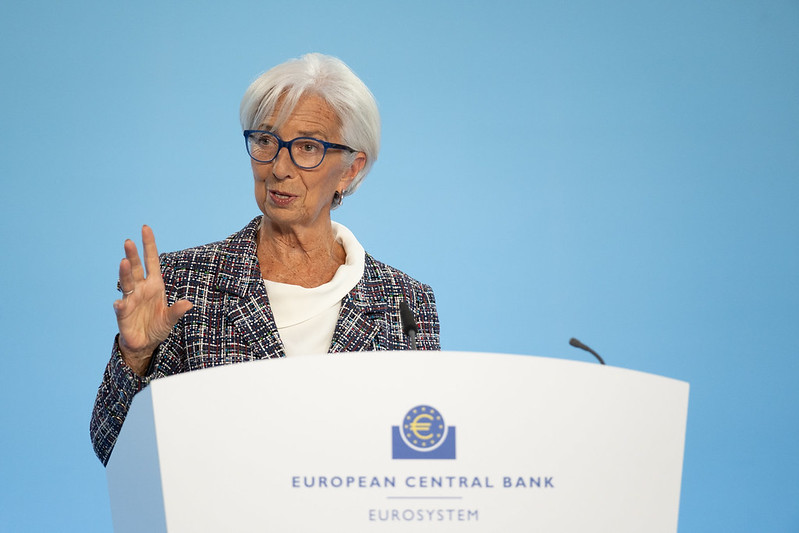Yesterday’s European Central Bank (ECB) meeting concluded without major surprises, resulting in limited movements in the financial markets. According to analyses by top international asset managers, the key takeaway from the meeting and subsequent remarks by Christine Lagarde, President of the ECB, was the emphasis on data-driven decisions.
Recent figures on service inflation and wages have not moderated as initially expected after the June rate cut. “The data flow in the coming months will determine the pace at which the ECB removes additional restrictions,” says Konstantin Veit, Portfolio Manager at PIMCO. The new projections, to be published in September, should confirm that inflation is systematically converging toward the target in the second half of 2025. Growth in the second quarter is expected to be lower than in the first, with restrictive monetary policy continuing to create challenging financing conditions, especially for companies. Before the September meeting, many data points will be released, providing sufficient confidence to resume cuts.
According to Felix Feather, Economist at abrdn, “This move reflects the ECB’s reluctance to extend its current cycle of cuts until new encouraging data is available. The central bank continued to emphasize its reliance on data, indicating that it is not committed to a specific rate path in advance.”
Salman Ahmed, Global Head of Macro and Strategic Asset Allocation at Fidelity International, notes that the ECB also downplayed the recent uptick in inflation, which it deemed temporary, and general wage pressures, which broadly align with its expectations. “Meanwhile, downside risks to growth, mainly due to the slow recovery of the industrial sector and weak credit dynamics affecting corporate investment demand, justify the ECB removing some degree of restriction. We will have two more months of data on inflation and employment, which should pave the way for cuts, barring any upward surprises,” Ahmed explains.
Inflation Analysis
Sandra Rhouma, Economist in the European Fixed Income team at AllianceBernstein, observes that the ECB’s reaction function remains unchanged, conditioned by core inflation dynamics, inflation outlook, and the strength of monetary policy transmission. “The statement highlights that most inflation indicators remained stable or decreased in June, although service inflation remains high at 4.1% in June. However, other core inflation indicators, excluding more volatile components, are at or below 2%,” she explains.
Rhouma expects core disinflation to continue and wage growth to relax in the second half of the year. “Regarding wages specifically, the ECB appears confident that profits have started to absorb the high wage growth, weakening the transmission to core prices,” she notes.
Dave Chappel, Senior Fixed Income Manager at Columbia Threadneedle Investments, points out that while growth risks remain to the downside, labor compensation is still recovering in some sectors due to post-COVID inflation increases. “The ECB remains confident that wages will ease in the coming quarters and return to levels that will allow inflation to sustainably reach the 2% target. As this happens, the central bank will take further normalization steps, likely starting in September,” he adds.
Forecast for Upcoming Cuts
Veit’s forecast is that the ECB will continue lowering official interest rates during expert projection meetings, with the next deposit facility rate cut expected in September. “Unlike earlier this year, current market prices seem reasonable and broadly align with our baseline of three cuts this year,” Veit adds.
Rhouma anticipates two additional cuts this year, in September and December, aligning with market expectations. “This pace of cuts seems most appropriate given the data dynamics and inflation outlook. Although reluctant to provide firm guidance, it is the pace some members, even among the hawks, have started to support. Structurally, nothing has changed in the Eurozone economy to justify neutral interest rates of 2.3% in 2-3 years, as currently valued by the market,” she clarifies.
Amundi expects a 25 basis points rate cut at the next meeting in September. “Although wage growth remains high and steady, President Lagarde seems to view it as a lagging indicator of inflationary pressure, and both she and the Council appear more concerned about slowing economic growth,” argues Guy Stear, Head of Developed Markets Strategy at Amundi.
Finally, Peter Goves, Head of Developed Markets Sovereign Debt Analysis at MFS IM, supports the baseline hypothesis of a cut in September.
“A cut is around 80% priced in for September. We believe the upcoming data should confirm the disinflationary narrative and allow for a cut at the next meeting. Along with the increasing likelihood of the Federal Reserve cutting rates (global factors dragging yields down), we see Bund yields falling in the second half, with a year-end target of 2.25%. This keeps us constructive on eurozone duration,” he argues.




